Did you know that some studies suggested that taking psilocybin mushrooms can potentially treat symptoms of certain mental issues, like anxiety and depression?
However, the DEA (Drug Enforcement Administration) continues to classify these mushrooms as a Schedule I substance under the Controlled Substances Act. As such, psilocybin has a high potential to be abused, and there are no accepted medical reasons one can have to take it.
This post explores psilocybin mushrooms, their origin, cultural use, and how they affect our brains when ingested. We make sure to also tell you what the side effects of psilocybin are and what the signs of abusing it look like.
Table of Contents
Psilocybin (Magic Mushroom): Understanding the Psychedelic Drug
Psilocybin is a naturally occurring psychedelic compound found in certain types of mushrooms, and by naturally occurring we mean that psilocybin exists in nature without human intervention.
Unlike other drugs that are synthesized in labs (e.g. cocaine or MDMA), you can find psilocybin in mushrooms that belong to the genus (or family)Psilocybe.
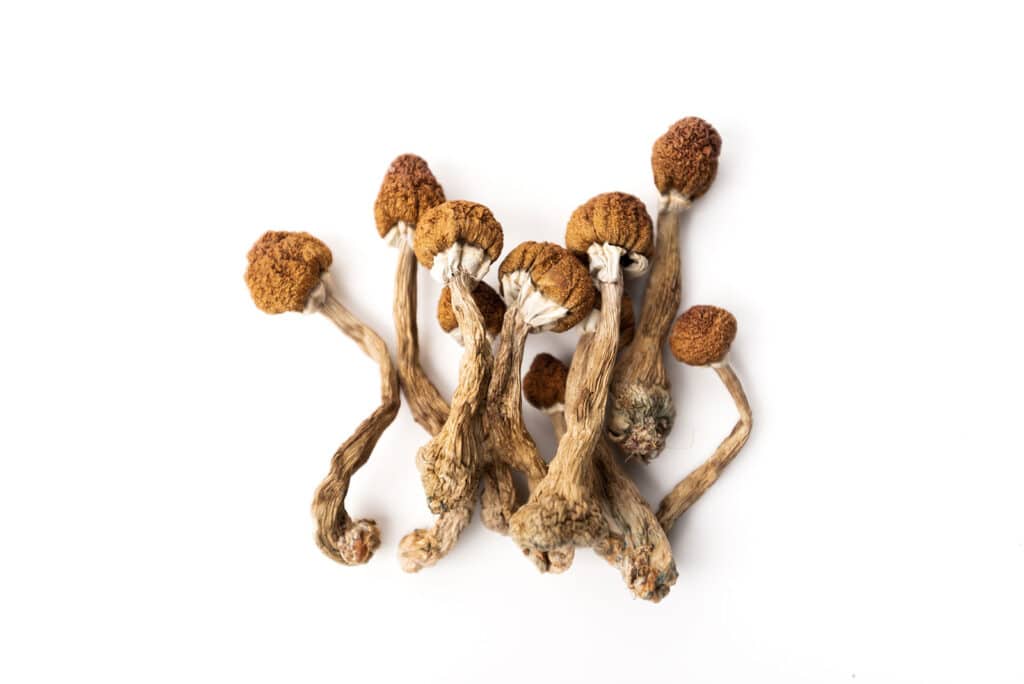
These specific types of mushroom are often referred to as ‘magic mushrooms’ or ‘shrooms’, Some common species include Psilocybe cubensis, Psilocybe semilanceata, and Psilocybe cyanescens.
Interestingly, the substance psilocybin is a tryptamine alkaloid that’s structurally similar to serotonin – which you’ve likely heard of already. Serotonin is a neurotransmitter involved in regulating our mood, sleep, and appetite.
What Do Psilocybin Mushrooms Look Like?
Magic mushrooms come in various shapes, sizes, and colors depending on the species. That said, there are some general characteristics that they share. To identify them, we need to look at the shroom’s cap, gill, and stem.
Interesting fact: Many psilocybin mushrooms will bruise blue or purple when handled – which is a helpful tip in identifying them.
Cap
Psilocybin mushrooms have a conical or bell-shaped cap. Its diameter ranges from 0.5 to 2.5 inches. The cap’s color will vary greatly—according to the species and age of the mushroom. However, common colors include light or dark brown with yellowish or reddish hues.
Gill
Gills are papery veils found underneath the cap. In psilocybin mushrooms, these gills are typically dark in color, often purplish-brown or black. If the mushroom is relatively long though, the gills will have a lighter color.
Stem
The stem of a psilocybin mushroom will always be slender and cylindrical, with a whitish or light brown coloration. Some species have stems that are smooth, while others have fibrous, scaly stems.
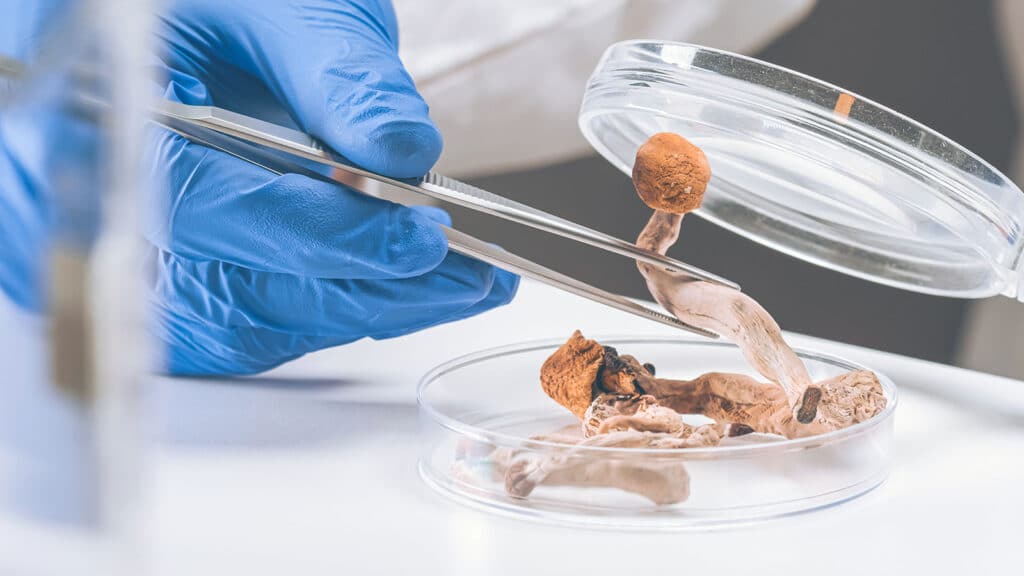
Where Are Magic Mushrooms Found?
Believe it or not, magic mushrooms grow naturally in various parts of the world. They typically thrive in moist environments, though, like forests, grasslands, and dung-rich pastures. These mushrooms also favor tropical and subtropical regions to others.
What Cultures Use Magic Mushrooms?
Interestingly, psilocybin mushrooms have a rich and long history, dating back to indigenous cultures in Central and South America. For centuries, these mushrooms have had spiritual, ceremonial, and recreational purposes.
Additionally, in these cultures, magic mushrooms were a common part of many religious rituals and healing ceremonies. People there believed that these mushrooms aided spiritual experiences and provided insights into the nature of existence.
How Do ‘Shrooms’ Affect Your Brain?
When you take magic mushrooms, your body metabolizes the psilocybin in them into psilocin. This compound interacts with your brain’s serotonin receptors, leading to alterations in perception, mood, and cognition.
On the one hand, some research suggests that ingesting psilocybin can then have its therapeutic potential. It can help ease the symptoms of certain mental health conditions, such as depression, anxiety, and addiction.
On the other hand, however, taking psilocybin still has its ugly side. It can cause visual distortions, mood swings, altered sense of time, and panic reactions.
Note: How psilocybin affects anyone varies based on certain factors. Those can be the surrounding environment, individual sensitivity, and dosage.
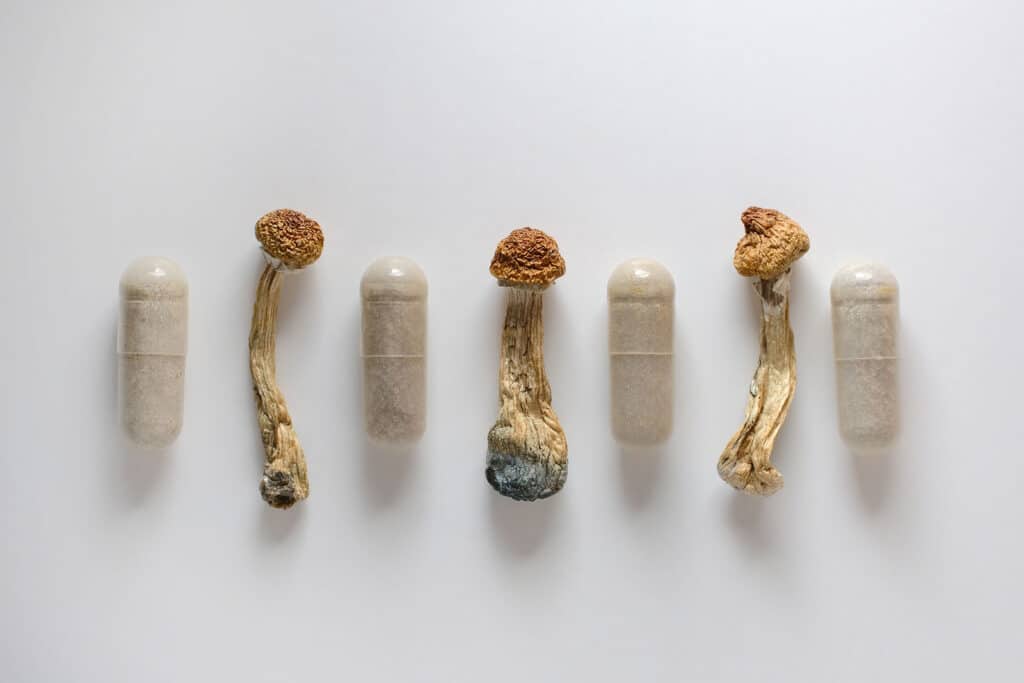
How Long Does It Take for Psilocybin Mushrooms to Kick In?
Factor in how you’re ingesting the psilocybin mushrooms and you have your answer. When eaten directly, for example, the shrooms would take around 30 minutes before taking effect.
If you drink the mushrooms instead, whether as a soup or a cup of tea, they’ll kick in after 5 to 10 minutes max. In either case, the shrooms will last in your system for about 4 to 6 hours.
What Are the Side Effects of Using Psilocybin?
The use of psilocybin can lead to various side effects, both short-term and long-term. Which of the side effects we cover in this section you experience will depend on the following:
- Your size, weight, and overall physical well-being
- Whether you mix the psilocybin with other drugs
- How strong the mushroom you picked is (strength varies according to the species)
With that, let’s take a look at the common side effects of using psilocybin.
Magic Mushrooms: Short-Term Side Effects
You can observe the short-term side effects of using magic mushrooms about 20 to 40 minutes after ingestion.
These effects will last for several hours afterward. During that time, many users report profound spiritual experiences. They may also go through a significant change in their sense of time and space. Other side effects include:
- Feelings of euphoria
- Perceptual alterations (usually manifest as visual and auditory hallucinations)
- Rapid heartbeat and high body temperature
- Gastrointestinal discomfort (i.e. nausea, vomiting, and stomach discomfort)
- Headaches (accompanied with pupil dilation)
Note: When taking magic mushrooms, there’s always a risk of experiencing a ‘bad trip’. These come with intense hallucinations that are highly unpleasant. With them will come feelings of fear, heightened anxiety, paranoia, and panic.
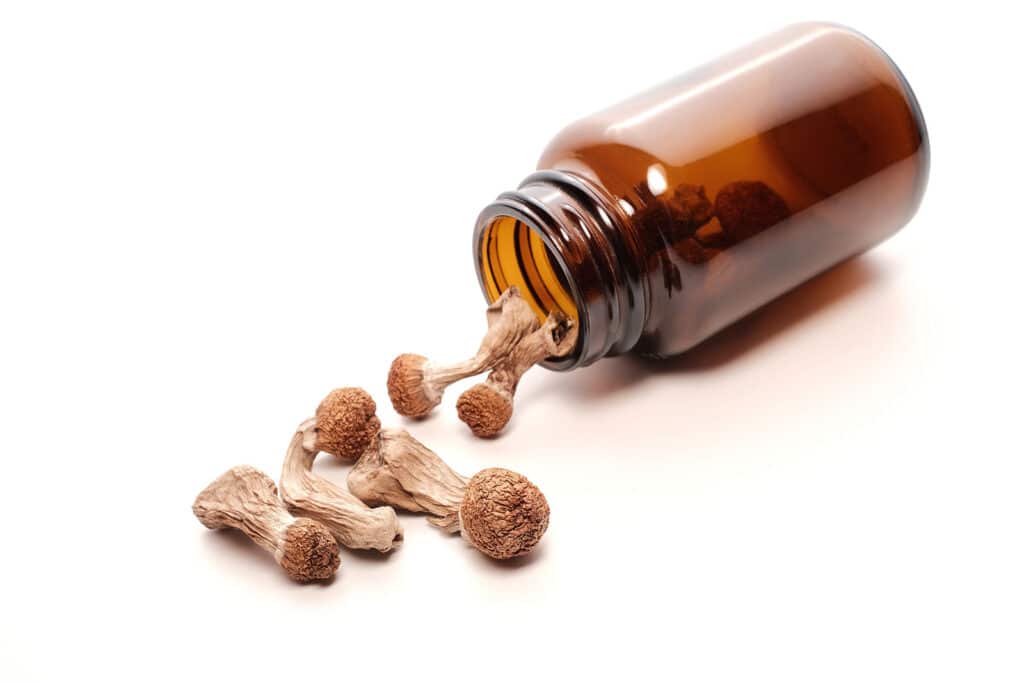
Magic Mushrooms: Long-Term Side Effects
Long-term use of psilocybin can lead to various physiological and psychological effects.
Let’s start with the physiological effects. Chronic use of shrooms may result in alterations in brain structure and function. Studies have found that long-term use of such psychedelic substances can potentially lead to significant changes to one’s neurotransmitter systems.
As a result, your brain’s neural connectivity is compromised. These changes have implications for mood regulation, cognition, and perception over time.
Then comes the long-term psychological effects. Abusing psilocybin with time can contribute to the development of psychiatric symptoms or disorders. One example is HPPD, otherwise known as hallucinogen-persisting perception disorder.
This disorder involves recurring visual disturbances, for instance, even after you stop taking the drug. Other HPPD symptoms may include visual flashes, colors appearing too bright, and hallucinating objects moving on their own.
Additionally, chronic use of shrooms has been associated with an increased risk of mood, anxiety, and psychotic disorders. These symptoms are more likely to occur in vulnerable individuals than they would in others.
How to Treat Psilocybin Mushrooms Addiction
Treating psilocybin mushrooms begins by seeking professional help for an assessment and diagnosis. Any of our addiction specialists can evaluate the severity of the addiction and assess any co-occurring mental health conditions. Based on their evaluation, they’ll then develop an appropriate treatment plan.
That said, treatment options for magic mushrooms usually include the following.
Dual Diagnosis Treatment
Many abusers of psilocybin mushrooms exhibit signs of underlying or co-occurring mental health disorders. Those can be depression, anxiety, or PTSD (post-traumatic stress disorder).
This is what’s also known as dual diagnosis – where someone shows a history of substance abuse disorder happening concurrently with a serious mental health disorder.
Treatment for a dual diagnosis will include addressing the underlying mental disorder and exploring the reason for the person’s substance abuse in therapy.
Psychotherapy and Counseling
Psychotherapy treatments include cognitive-behavioral therapy (CBT), motivational interviewing (MI), and dialectical behavior therapy (DBT). The aim of these therapies is to address the underlying causes of your shroom addiction.
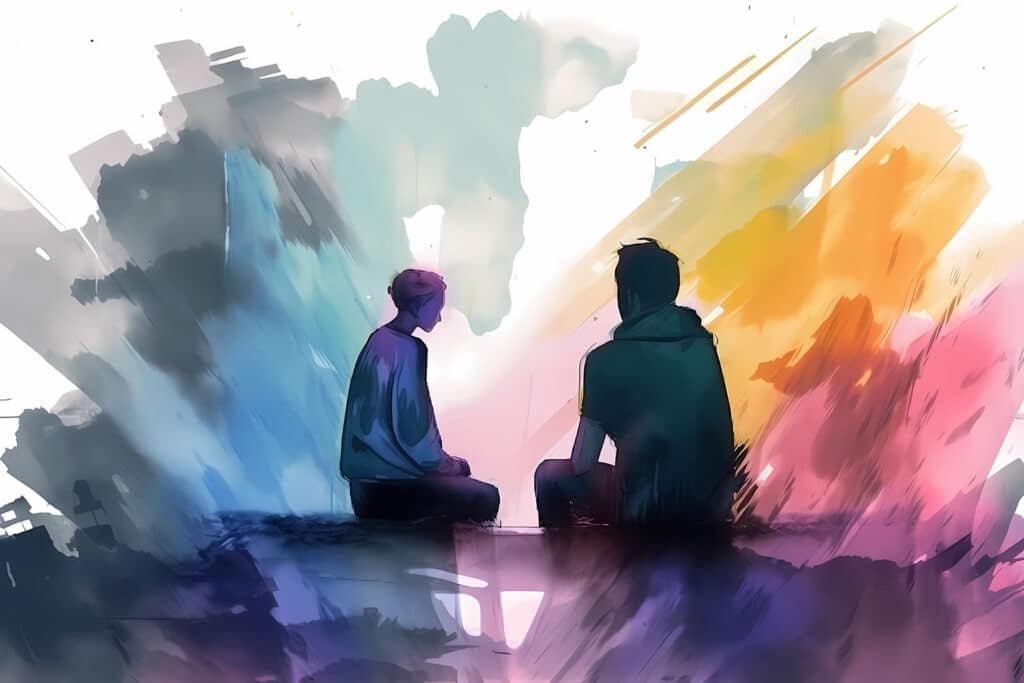
These therapies will also help you better manage cravings and develop coping skills to prevent relapse. It’s these evidence-based practices (EBP) that we at Illinois Recovery Center believe can help our patients make a full recovery.
Support Groups
Peer support groups and group therapy are highly effective treatment options for any type of addiction, not just the mushroom kind. By talking to individuals battling the same challenges, you learn how to better cope with and manage your cravings.
It’s not just the shared experience either. Group therapy offers a supportive environment where members encourage each other and validate one another’s struggles. Their support helps you feel understood, accepted, and motivated. You learn to grow with them and learn from their perspectives, experiences, mistakes, and coping strategies.
Recovering from Psilocybin Mushroom Addiction
At the Illinois Recovery Center, we believe there’s hope for anyone suffering from an addiction. We assure our patients that recovery is always possible at the hands of our addiction specialists and medical professionals.
If you or a loved one is battling with short- or long-term abuse of magic mushrooms, contact us today and let us help you figure out the best program for you. Choose from our extensive list of treatment options the one that’s most suited for your needs and preferences.
And the journey with us doesn’t end there. We also offer our patients aftercare programs to help prevent relapse and assist them as they live soberly. So, make sure to inquire about those too when you call us!



